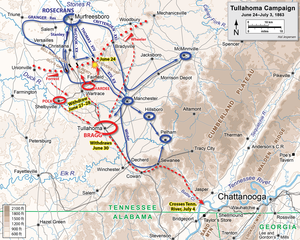Battle of Liberty Gap
| Battle of Liberty Gap | |||||||
|---|---|---|---|---|---|---|---|
| Part of the American Civil War | |||||||
 |
|||||||
|
|||||||
| Belligerents | |||||||
|
|
|
||||||
| Commanders and leaders | |||||||
| Alexander M. McCook | St. John R. Liddell | ||||||
| Units involved | |||||||
| XX Corps | Hardee's Corps | ||||||
| Casualties and losses | |||||||
| unknown | unknown | ||||||
The Battle of Liberty Gap was fought during the Tullahoma Campaign of the American Civil War. The battle was an early instance of mounted infantry using Spencer repeating rifles during the war similar to the concurrent battle of Hoover's Gap.
Following the retreat after the Battle of Stones River, Gen. Braxton Bragg, commander of the Army of Tennessee, established a fortified line along the Duck River from Shelbyville to Wartrace. On the Confederate right, infantry and artillery detachments guarded Liberty, Hoover's, and Bellbuckle gaps through the mountains. Maj. Gen. William S. Rosecrans, commanding the Army of the Cumberland, feigned an attack on Shelbyville but massed against Bragg's right. His troops struck out toward the gaps with George H. Thomas and the XIV Corps moved against Hoover's Gap. Moving against Liberty Gap was Alexander M. McCook and the XX Corps.
On June 24 McCook sent a brigade under Colonel Luther P. Bradley against the Confederate pickets from General St. John R. Liddell's brigade holding the crossroads at the gap. Bradley's men were screened by Colonel Thomas J. Harrison's 39th Indiana Mounted Infantry Regiment armed with Spencer repeating rifles. Harrison's mounted infantry moved so quickly they captured the crossroad at a cost of only one man wounded. Hearing the gap was lightly defended McCook wanted to take advantage of the situation and sent Brig. Gen. August Willich's brigade forward. Though the gap was held in fact only by two Arkansas infantry regiments and an artillery battery, Willich determined they were in a good defensible position. Willich attempted to flank the Confederates with the 32nd Indiana Infantry on the left and Harrison's mounted infantry on the right. The Union and Confederate forces launched attacks and counter-attacks while McCook sent forward the 77th Pennsylvanian and 29th Indiana infantry regiments for support. Liddell saw the futility of attempting to hold the gap and withdrew his forces.
...
Wikipedia
